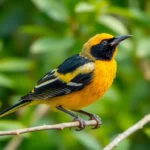We’ve all seen countless seabirds along rocky coastlines, but few capture our attention quite like the magnificent razorbill. With its distinctive flattened bill and striking black-and-white plumage, this remarkable seabird stands out as one of North America’s most fascinating coastal residents.
The razorbill isn’t just another pretty face in the avian industry – it’s a master of both air and sea. These incredible birds can dive up to 400 feet beneath ocean waves while maintaining perfect flight capabilities above. What makes them truly special is their unique evolutionary story and the critical role they play in marine ecosystems.
Unfortunately, many people overlook these extraordinary creatures even though their impressive abilities and conservation importance. We’re here to change that by diving deep into the razorbill’s industry, exploring everything from their remarkable hunting techniques to their fascinating breeding behaviors and the conservation challenges they face today.
What Is a Razorbill Bird
The razorbill (Alca torda) stands as the sole surviving member of the genus Alca within the auk family Alcidae. These distinctive seabirds measure 15-17 inches in length and weigh between 1.1-1.8 pounds. Their wingspan reaches 24-27 inches across open waters.
Razorbills display striking black and white plumage that changes seasonally. During breeding season, adults develop deep black heads, backs, and wings contrasted by brilliant white underparts. A thin white line extends from the eye to the bill, creating their signature facial marking. Winter plumage transforms the black throat and cheeks to white, maintaining the species’ classic monochrome appearance.
The razorbill’s most recognizable feature remains its flattened, blade-like bill marked with distinctive white grooves. This specialized tool evolved specifically for catching and holding slippery fish underwater. Adult bills measure approximately 1.3 inches in length and compress laterally to create the “razor” effect that gives these birds their common name.
These medium-sized auks inhabit North Atlantic waters exclusively. Razorbills nest on rocky coastal cliffs from eastern Canada to Norway, with major colonies located in Newfoundland, Scotland, and Iceland. Population estimates place global razorbill numbers at approximately 1.2 million individuals across their circumpolar range.
Razorbills spend most of their lives at sea, coming ashore only during the 4-month breeding season from May through August. They demonstrate remarkable diving abilities, plunging to depths of 400 feet to pursue small schooling fish like herring, sardines, and anchovies. Underwater propulsion occurs through powerful wing strokes, allowing razorbills to “fly” beneath the surface at speeds reaching 4.9 feet per second.
Their taxonomic classification places razorbills closest to the extinct great auk, sharing evolutionary adaptations for marine life. Modern razorbills represent one of 25 living alcid species, occupying a crucial ecological niche as both predator and prey within North Atlantic marine food webs.
Physical Characteristics of the Razorbill
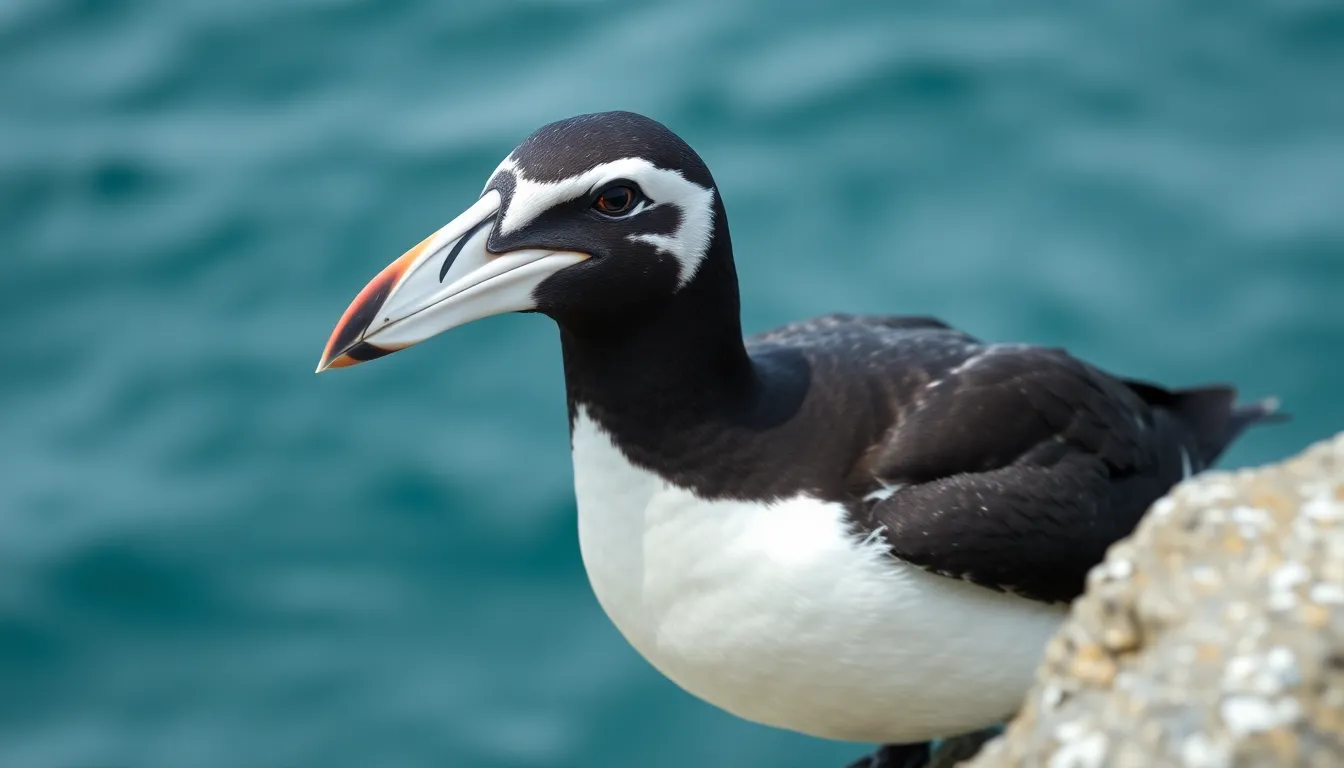
Razorbill birds possess distinct physical features that make them easily recognizable among seabirds. Their unique adaptations reflect millions of years of evolution for life in marine environments.
Distinctive Bill and Coloring
The razorbill’s flattened, blade-like bill stands as its most recognizable feature, measuring 1.2-1.4 inches in length with distinctive white markings that create a grooved pattern. This compressed, laterally flattened bill structure enables efficient underwater fish capture while reducing drag during swimming.
Adult razorbills display striking seasonal plumage variations throughout the year. During breeding season from May through August, males and females develop deep black heads, necks, and backs with bright white underparts extending from the throat to the belly. A thin white line connects the eye to the bill base, creating a distinctive facial pattern that aids in species identification.
Winter plumage transforms dramatically as black head coloring fades to brownish-gray on the crown and nape while the throat and sides of the neck turn white. The bill also changes from bright colors during breeding season to a duller appearance in winter months.
Size and Body Structure
Razorbill birds measure 15-17 inches in total length with adult males typically larger than females, though sexual dimorphism remains relatively subtle. Their compact, torpedo-shaped bodies weigh between 1.1-1.8 pounds, with breeding adults reaching peak weights of 1.6-1.8 pounds.
Wingspan measurements range from 24-27 inches, providing efficient flight capabilities both above water and underwater propulsion. Their wings appear narrow and pointed, adapted for both aerial flight and underwater “flying” while pursuing fish at depths up to 400 feet.
The razorbill’s legs are positioned far back on the body, creating an upright stance on land but maximizing swimming efficiency in water. Their webbed feet measure approximately 2 inches long with sharp claws that provide secure grip on rocky cliff surfaces during nesting periods.
| Physical Measurement | Range | Notes |
|---|---|---|
| Total Length | 15-17 inches | Males slightly larger |
| Weight | 1.1-1.8 pounds | Breeding adults heavier |
| Wingspan | 24-27 inches | Narrow, pointed wings |
| Bill Length | 1.2-1.4 inches | Laterally compressed |
| Foot Length | ~2 inches | Webbed with sharp claws |
Razorbill Habitat and Distribution
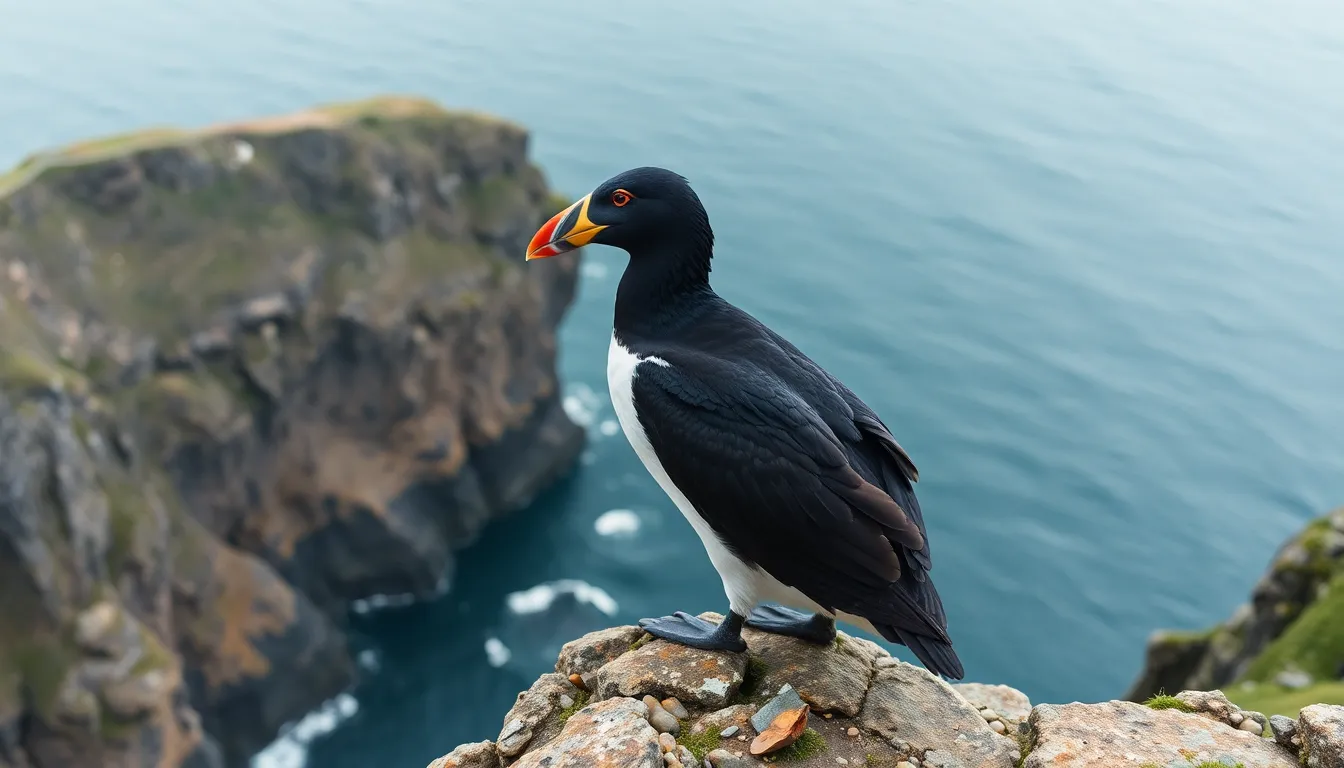
Razorbills inhabit the cold waters of the North Atlantic Ocean, establishing colonies along rocky coastlines from eastern Canada to northern Europe. These remarkable seabirds demonstrate exact preferences for nesting sites that provide both protection and access to rich feeding grounds.
Preferred Nesting Locations
Rocky cliff faces serve as the primary nesting habitat for razorbill colonies across their range. These seabirds select ledges and crevices on steep coastal cliffs that offer protection from predators and harsh weather conditions. Islands with granite or limestone formations provide ideal nesting substrates, with colonies often establishing on cliff heights ranging from 30 to 650 feet above sea level.
Razorbills prefer narrow ledges where single pairs can establish territories measuring 3 to 6 feet in diameter. The birds seek out sites with natural windbreaks such as rock overhangs or boulder formations that shield their single eggs from exposure. Vegetation-free areas receive priority as nesting locations since razorbills require clear takeoff zones for their relatively small wing-to-body ratio.
Colony sites typically feature proximity to productive fishing waters within 6 miles of the nesting location. Razorbills select areas where ocean currents create upwelling zones that concentrate small schooling fish including herring, sardines, and sprat. The availability of suitable crevices often determines colony density, with established sites supporting 50 to 500 breeding pairs per location.
Geographic Range
The razorbill’s breeding range extends across the North Atlantic from Labrador and Newfoundland in the west to Iceland, the Faroe Islands, and coastal Norway in the east. Major breeding populations establish colonies along the coasts of eastern Canada, Maine, the Bay of Fundy, and the Maritime Provinces. European populations concentrate in Iceland (approximately 400,000 pairs), the United Kingdom (130,000 pairs), Ireland (24,000 pairs), and Norway (100,000 pairs).
During winter months razorbills migrate to warmer offshore waters, with North American populations moving south along the Atlantic coast to areas off North Carolina and Virginia. European birds disperse throughout the North Sea, English Channel, and Bay of Biscay, with some individuals reaching as far south as Portugal and western France.
| Region | Breeding Pairs | Key Locations |
|---|---|---|
| Iceland | 400,000 | Westman Islands, Grimsey |
| Norway | 100,000 | Lofoten Islands, coastal fjords |
| United Kingdom | 130,000 | Scotland, Wales, northern England |
| Eastern Canada | 45,000 | Newfoundland, Nova Scotia, New Brunswick |
| Ireland | 24,000 | Western and southern coasts |
Razorbills occupy waters with temperatures ranging from 32°F to 68°F, preferring areas where surface temperatures remain below 59°F during the breeding season. Ocean depth preferences vary from shallow coastal waters of 30 feet to deep offshore areas exceeding 600 feet, depending on prey availability and seasonal migration patterns.
Behavior and Lifestyle
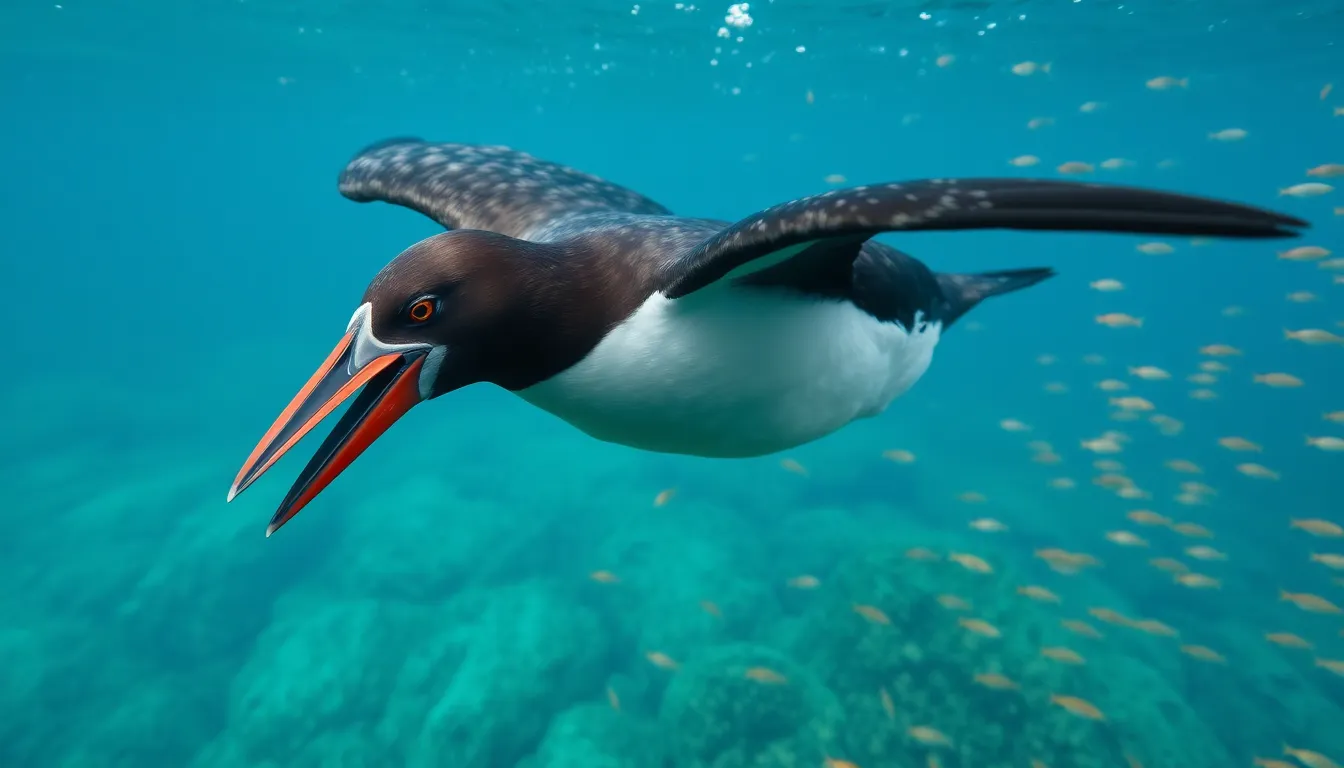
Razorbills exhibit fascinating behavioral patterns that reflect their dual nature as aerial and aquatic specialists. These remarkable seabirds demonstrate complex social structures and feeding strategies that we’ve observed through decades of research.
Feeding Habits and Diet
Razorbills pursue fish through pursuit diving, reaching depths of 20 to 80 feet beneath the surface. Their streamlined bodies propel them underwater at speeds exceeding 4.5 miles per hour using synchronized wing beats. Small schooling fish comprise 85% of their diet, including herring, sardines, anchovies, and sprat.
Hunting occurs primarily during daylight hours when fish visibility peaks. Adults consume approximately 2.8 ounces of fish daily during the breeding season. Their flattened bills capture multiple small fish crosswise, allowing them to carry 6 to 10 fish simultaneously back to nesting sites.
Feeding territories extend 3 to 12 miles from breeding colonies depending on prey availability. Peak foraging activity occurs between 6 AM and 10 AM when fish congregate near the surface. Razorbills adjust their diving patterns based on tidal movements and weather conditions.
Social Behavior and Flocking Patterns
Razorbills form dense breeding colonies ranging from 50 to 15,000 pairs on suitable cliff faces. Colony formation begins in late April when birds return from winter dispersal areas. Established pairs demonstrate strong site fidelity, returning to the same narrow ledges year after year.
Communication involves distinctive calls including harsh croaking sounds and soft purring notes between mates. Courtship displays feature synchronized head movements and bill touching ceremonies that strengthen pair bonds. Males defend territories measuring 3 to 6 square feet around nest sites through aggressive posturing and occasional physical confrontations.
Winter flocking patterns differ significantly from breeding behavior. Groups of 50 to 200 individuals gather on productive offshore fishing grounds. These winter flocks remain loosely organized, allowing rapid dispersal when predators approach or feeding opportunities arise elsewhere.
Breeding and Reproduction
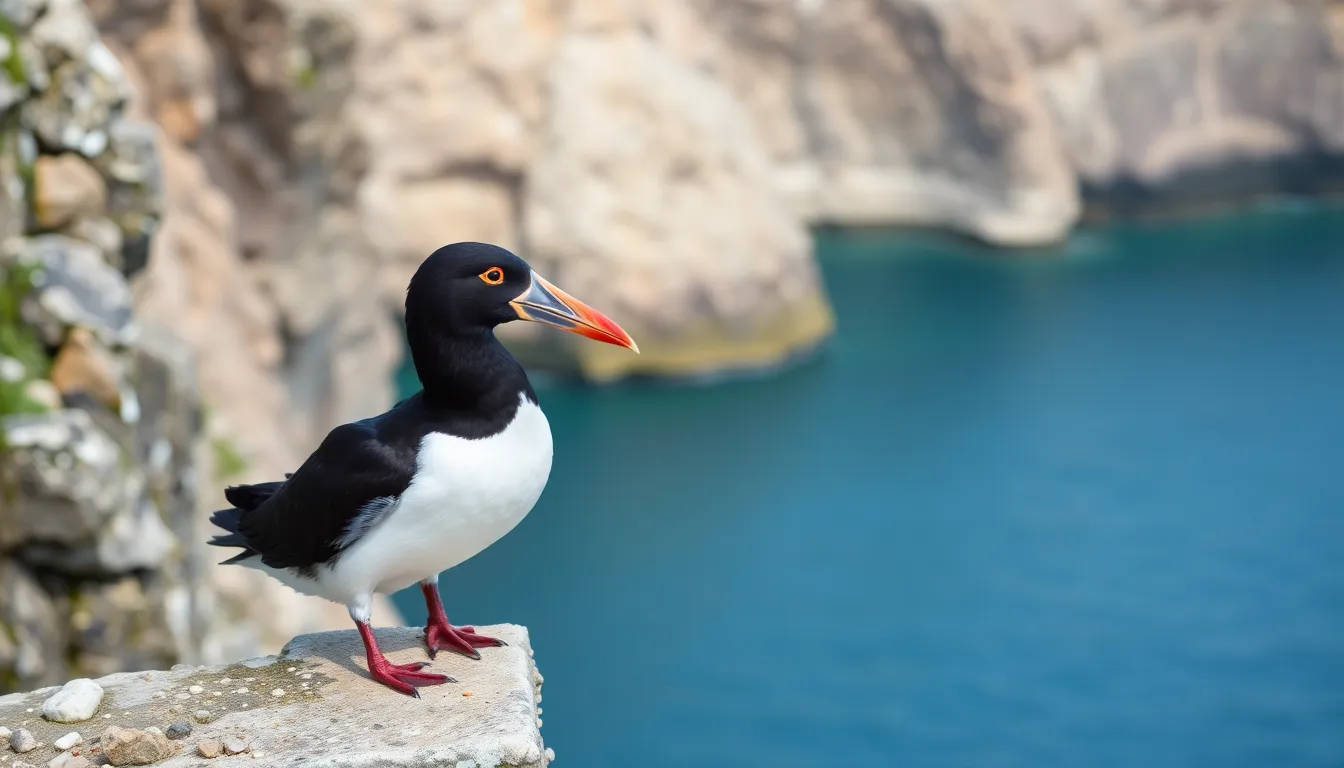
Razorbills demonstrate remarkable breeding behaviors that ensure species survival through carefully timed reproduction cycles. These seabirds return to the same coastal colonies each year to engage in complex courtship rituals and raise their single offspring.
Mating Season and Courtship
Breeding season begins in early May when razorbills arrive at their traditional cliff colonies after months at sea. Pairs establish territories on narrow ledges measuring 12 to 24 inches wide, defending these spaces from other breeding pairs through aggressive posturing and bill displays.
Males initiate courtship by performing ritualized head movements and producing distinctive growling calls that carry across the colony. They present small fish to potential mates while extending their necks and vibrating their bills in synchronized patterns. Females respond to successful suitors by mirroring these movements and accepting fish offerings.
Established pairs engage in mutual preening sessions that strengthen their bond throughout the 4 month breeding period. Both partners participate in nest preparation activities including clearing debris from ledges and arranging small stones into protective barriers. Mating occurs multiple times during the 3 week pre-laying period to ensure fertilization success.
Razorbills exhibit strong site fidelity, returning to identical ledge locations for consecutive breeding seasons. Pairs that successfully raise chicks together demonstrate partnership loyalty rates exceeding 85% in subsequent years. These long term bonds contribute to improved breeding success as experienced pairs coordinate their efforts more effectively.
Nesting and Chick Rearing
Females lay a single large egg directly on bare rock surfaces without constructing traditional nests. The egg measures approximately 3 inches long and weighs about 2.8 ounces, representing nearly 15% of the female’s body weight. Incubation duties alternate between both parents in shifts lasting 2 to 4 hours over a 35 day period.
Parents develop specialized brood patches with increased blood vessel density to maintain egg temperature at 99.5°F throughout incubation. During changeovers, the attending parent carefully positions the egg against their warm belly while the partner departs for feeding trips lasting up to 6 hours.
Newly hatched chicks weigh approximately 2.1 ounces and remain on the ledge for 18 to 25 days before fledging. Parents deliver whole fish crosswise in their bills, carrying up to 10 small fish simultaneously during peak feeding periods. Chicks consume an average of 40 fish daily during their rapid growth phase.
Fledgling razorbills make dramatic nighttime departures by jumping from cliffs into darkness below. Males accompany their offspring to sea where they continue feeding and protecting the young birds for an additional 4 to 6 weeks. This extended parental care ensures chicks develop sufficient diving skills and strength before achieving complete independence.
Conservation Status and Threats
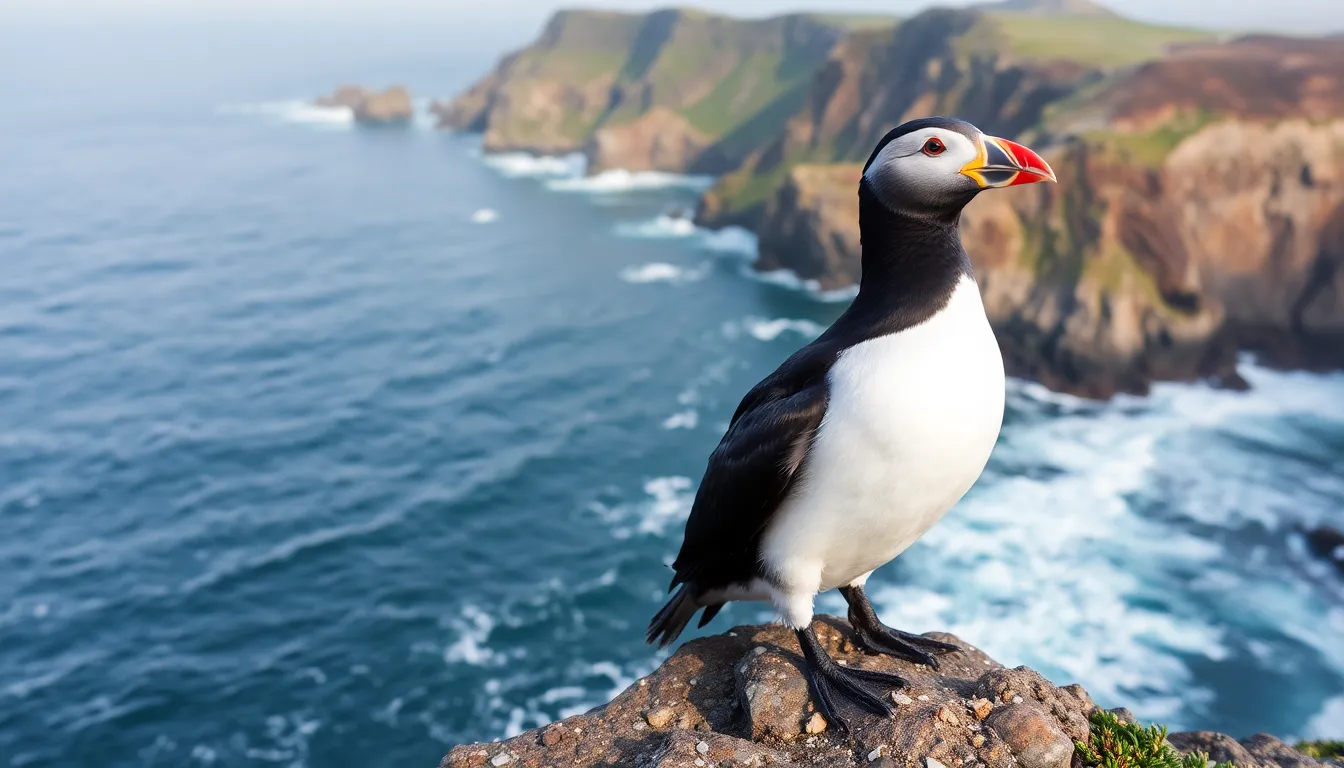
Razorbill populations face mounting pressure from human activities and environmental changes across their North Atlantic range. Current conservation assessments classify these remarkable seabirds as a species requiring careful monitoring and protective measures.
Population Trends
Global razorbill populations currently number approximately 1.2 million individuals distributed across breeding colonies from eastern Canada to Norway. Recent surveys indicate stable to slightly increasing trends in several key breeding areas including Iceland and the Faroe Islands. European populations demonstrate particular resilience with colonies in Scotland and Ireland showing modest growth over the past decade.
North American razorbill numbers present a more complex picture with some colonies experiencing fluctuations tied to regional ocean conditions. Monitoring data from Machias Seal Island and other Maritime breeding sites reveals variable annual productivity rates ranging from 0.3 to 0.8 fledglings per pair. Atlantic Canada supports roughly 85% of North American breeding razorbills with an estimated 45,000 to 50,000 pairs concentrated across key island colonies.
Population assessments face challenges due to razorbills’ remote nesting locations and their tendency to shift between alternative colony sites during unfavorable conditions. Scientific surveys employ standardized counting methods during peak breeding periods to track long term demographic trends across the species’ range.
Environmental Challenges
Climate change presents the most important threat to razorbill populations through alterations to marine food webs and ocean temperatures. Warming North Atlantic waters push preferred prey species like herring and sand eels into deeper or more northerly waters beyond typical foraging ranges. Surface water temperature increases of 1 to 2 degrees Celsius in key feeding areas directly correlate with reduced breeding success in monitored colonies.
Ocean acidification compounds these challenges by affecting the abundance of small fish that form the foundation of razorbill diets. Plastic pollution poses an additional threat as razorbills mistake floating debris for prey items leading to ingestion of non digestible materials. Marine vessel traffic increases collision risks and creates noise disturbance in critical feeding areas.
Coastal development pressures threaten traditional nesting sites through habitat modification and increased human disturbance during sensitive breeding periods. Oil spills represent acute threats to razorbill populations with their dense waterproof plumage making them particularly vulnerable to petroleum contamination. Historical hunting pressure eliminated razorbill populations from former southern breeding ranges including Maine and Massachusetts requiring ongoing protection to prevent similar losses.
Best Places to Observe Razorbill Birds

Prime razorbill watching locations span the North Atlantic coastline, offering exceptional opportunities to witness these remarkable seabirds in their natural habitat. Machias Seal Island off the coast of Maine provides one of North America’s most accessible razorbill viewing experiences, with over 5,000 pairs nesting on the island’s rocky ledges from May through August.
Newfoundland’s coastal cliffs host the largest North American breeding populations, particularly at Cape St. Mary’s Ecological Reserve where visitors can observe thousands of razorbills alongside other seabird species. Witless Bay Ecological Reserve near St. John’s offers boat tours that approach within 150 feet of active colonies during peak breeding season.
Faroe Islands represent the heart of European razorbill territory, with Mykines supporting approximately 45,000 breeding pairs on dramatic cliff faces rising 2,300 feet above the Atlantic. Iceland’s Westman Islands provide equally spectacular viewing opportunities, hosting nearly 350,000 pairs across multiple colony sites accessible by organized boat excursions.
Scotland’s coastal regions offer diverse razorbill watching locations, including the Isle of May in the Firth of Forth where 12,000 pairs nest annually. Bempton Cliffs in Yorkshire, England features well-maintained viewing platforms positioned 400 feet above sea level, allowing close observation of razorbill behaviors without disturbing the colonies.
Norwegian fjords provide the northernmost razorbill viewing experiences, with Lofoten Islands hosting substantial populations on towering granite cliffs. Bear Island in the Svalbard archipelago marks the species’ extreme northern breeding range, supporting approximately 8,000 pairs in one of the Arctic’s most pristine seabird environments.
Timing considerations prove crucial for successful razorbill observation, as peak colony activity occurs between June and July when adults actively feed chicks. Early morning hours from 5:00 AM to 9:00 AM offer optimal viewing conditions with increased flight activity and feeding behaviors. Calm weather periods enhance observation quality, as razorbills remain closer to colony sites during stable atmospheric conditions.
Boat based excursions provide the most comprehensive razorbill viewing experiences, allowing observers to witness diving behaviors and feeding techniques impossible to see from shore. Land based observation points offer extended viewing periods and opportunities to document breeding behaviors, courtship displays, and parent-chick interactions throughout the nesting season.
Conclusion
The razorbill stands as a testament to nature’s remarkable adaptability and the intricate balance of marine ecosystems. Through our exploration of this extraordinary seabird we’ve discovered a species that’s perfectly evolved for life between sea and sky.
As we face mounting environmental challenges these resilient birds remind us of our responsibility to protect coastal habitats and marine environments. Their future depends on our collective commitment to conservation efforts and sustainable practices.
We encourage you to seek out opportunities to witness razorbills in their natural habitat. Whether you’re watching from coastal cliffs or joining boat excursions these encounters offer profound connections to the wild beauty of our Atlantic shores and inspire deeper appreciation for marine wildlife conservation.
Frequently Asked Questions
What is a razorbill and where can I find them?
The razorbill (Alca torda) is a striking black-and-white seabird and the sole surviving member of the genus Alca. These seabirds inhabit the cold waters of the North Atlantic Ocean, nesting on rocky coastal cliffs from eastern Canada to Norway. With an estimated global population of around 1.2 million individuals, they spend most of their lives at sea, coming ashore only during breeding season from May to August.
How big are razorbills and what do they look like?
Razorbills measure 15-17 inches in length, weigh between 1.1-1.8 pounds, and have a wingspan of 24-27 inches. Their most distinctive feature is their flattened, blade-like bill measuring 1.2-1.4 inches. They display striking black-and-white plumage that changes seasonally, with adults developing deep black heads and backs during breeding season and transitioning to brownish-gray coloring in winter.
What makes the razorbill’s bill so special?
The razorbill’s flattened, blade-like bill is specifically evolved for catching slippery fish underwater. This unique adaptation, combined with white markings that aid in species identification, enhances their fishing efficiency. The bill’s design allows them to capture multiple small fish at once during their underwater hunting expeditions, making them highly effective marine predators.
How deep can razorbills dive when hunting?
Razorbills are impressive divers that can reach depths of 20 to 80 feet while hunting for fish, though they’re capable of diving up to 400 feet. They use pursuit diving techniques to catch small schooling fish and can adjust their foraging patterns based on environmental conditions. Their torpedo-shaped bodies and specialized adaptations make them highly efficient underwater hunters.
Where do razorbills nest and breed?
Razorbills establish breeding colonies on rocky cliff faces ranging from 30 to 650 feet above sea level. They prefer narrow ledges that offer protection and access to rich feeding grounds, requiring clear takeoff zones and proximity to productive fishing waters. Major breeding populations exist from Labrador and Newfoundland to Iceland, the Faroe Islands, and coastal Norway.
How do razorbills reproduce and care for their young?
Razorbills engage in complex courtship rituals beginning in early May, with males performing head movements and presenting fish to potential mates. They lay a single large egg on bare rock, with both parents sharing incubation duties. After hatching, chicks remain on the ledge for 18 to 25 days, receiving extensive parental care before making dramatic nighttime departures to the sea.
What threats do razorbills face in the wild?
Razorbill populations face multiple threats including climate change, ocean acidification, plastic pollution, and coastal development. While their current conservation status requires careful monitoring, some North American colonies experience fluctuations due to changing ocean conditions. These environmental pressures pose significant challenges to their long-term survival and highlight the need for ongoing conservation efforts.
When and where is the best time to observe razorbills?
The best time to observe razorbills is during their breeding season from May to August, particularly in early morning hours during calm weather. Prime viewing locations include Machias Seal Island in Maine, Cape St. Mary’s Ecological Reserve in Newfoundland, and the Faroe Islands. Both boat-based excursions and land-based observation points offer excellent opportunities to witness their behaviors.





